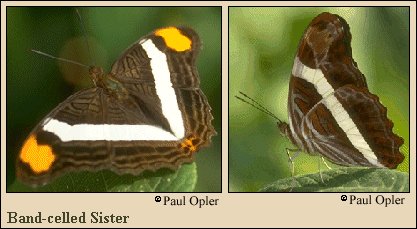 |
 

 |



Mexican Sister (Adelpha fessonia [Hewitson])
Wing span: 2 3/16 - 2 3/4 inches (5.6 - 7 cm).
Identification: Upperside is dark brown with an orange forewing apex. White median band across both wings reaches the forewing leading edge.
Life history: Males perch in light gaps, along forest edges, or in the canopy. Females lay eggs singly on leaves of host plants in light gaps and forest edges.
Flight: March-April and July-December in Texas, March-November in Mexico and Central America, perhaps all year in Costa Rica.
Caterpillar hosts: Hackberry Celtis lindheimeri in Texas.
Adult food: Nectar from flowers such as Cordia, Croton, and Baccharis; decaying fruit.
Habitat: Forest edges and trails near streams.
Range: Panama north through Central America to Mexico. A periodic resident in the lower Rio Grande Valley, Texas.
Conservation: Not required for rare stray and infrequent resident.
The Nature Conservancy Global Rank: G4 - Apparently secure globally, though it might be quite rare in parts of its range, especially at the periphery.
Management needs: None reported.
References:
DeVries, P. J. 1987. The butterflies of Costa Rica and their natural history.
Papilionidae, Pieridae, Nymphalidae. Princeton University Press, Princeton,
New Jersey. 327 pages, 50 color plates.
Opler, P. A. and V. Malikul. 1992. A field guide to eastern butterflies. Peterson
field guide #4. Houghton-Mifflin Co., Boston. 396 pages, 48 color plates.
Scott, J. A. 1986. The butterflies of North America. Stanford University Press,
Stanford, Calif. 583 pages, 64 color plates.
Author: Jane M. Struttmann

